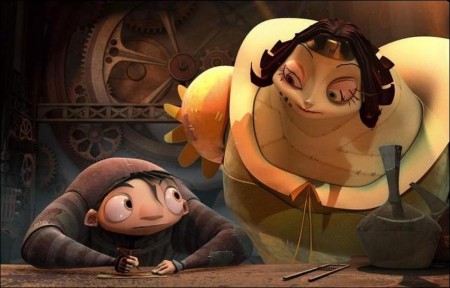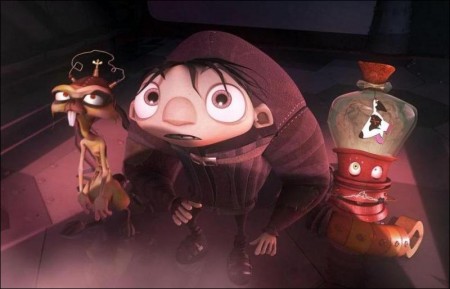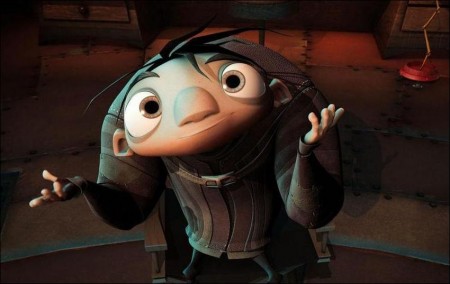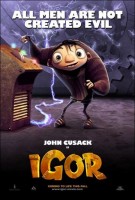Tagline: All men are not created devil.
In a land of mad scientists and diabolical inventions, what do you do when you’re born with a hunch on your back? You become an Igor.
The story of one Igor who’s sick of being a lowly lab assistant with a Yes Masters’ degree and dreams of becoming a scientist. When his cruel master kicks the bucket a week before the annual Evil Science Fair, Igor finally gets his chance.
With the help of two of his experimental creations – Brain, a brain in a jar who’s a little light on brains, and Scamper, a cynical bunny brought back from being road kill, Igor embarks on building the evil invention, a huge, ferocious monster. Unfortunately, instead of turning out evil, the monster turns out as Eva, a giant aspiring actress who wouldn’t hurt a fly.
Just when the load on his back can’t get any heavier, Igor and his band of monstrous misfits uncover an evil plot that threatens their world. Now, they must fight to save it and prove that heroes come in all shapes and sizes.
About The Production
At its heart, IGOR is a story of hope and how the most unlikely people can change the world. For screenwriter Chris McKenna, it all began with a simple idea. A lifelong fan of horror films, he set out to create a riff on FRANKENSTEIN and other evil scientist films by flipping that world upside down – turn the slurring, hunchbacked lab assistant into a genius, the evil genius into a fraud, the evil monster into a sweetheart, the brain-in-a-jar to an idiot, and so on. “I got stuck on this notion of a dark, stormy Transylvania-like universe and wanted to explore that setting,” said McKenna. “Then I found myself wondering about Igor – there’s one in every evil scientist film ever made – who is he and where did he come from? What’s his story?”
For director Tony Leondis, McKenna’s slightly twisted take on a classic tale immediately intrigued him and sparked visions of creating a film with a look that was completely unique. Also a life-long fan of horror films, as well as of film noir and German expressionism, Leondis envisioned a world of gothic romanticism that was creepy but accessible and populated with characters and plot points reminiscent of classic gothic novels – the curse on a village, the downtrodden servant turned hero, the innocent girl – all realized with a very strong visual take and wrapped in a modern-day allegory with generous amounts of humor.
“From the first time I read Chris’ script, I just loved everything about it,” said Leondis. “We have the same off-beat, sardonic humor and I was fascinated with the idea of exploring this world and its characters and bringing a unique perspective and look to it.”
To bring the audience into that world and allow them to really connect to the story and its characters, Leondis wanted to give them an entirely new vision of Mad Scientists and Evil Inventions as well as bring in a few subtle parallels and references to current issues. “My goal was to take familiar monster motifs and rearrange them in a surprisingly fun way to evoke the memories that people have of classic monster movies. Something familiar enough to connect to, but at the same time fresh and unexpected so that it became a fun ride – and maybe makes them think a little along the way.”
To accomplish this, Leondis and McKenna continuously worked on further developing the world of Malaria and its characters. “I feel it got better and stronger as it developed,” said McKenna. “Tony and I really clicked and shared a lot of the same sensibilities and we had an incredible creative team. The final result is a reflection of the talents of everyone involved.”
In a lot of ways, it seemed like a simple story to tell: In a world of evil scientists and hunchbacked Igors, one Igor wants to be a scientist. But as McKenna soon found out, setting up the world was perhaps the hardest thing to conquer.
Besides laying out the deceptively simple concept of Igors, the backstory of why this land became the way it was needed to be explained and an assortment of very particular characters had to be introduced. “We tried a variety of different ways to get all that information out in as entertaining a way as possible,” said McKenna. “It was a very collaborative experience with the director, the producers, and the actors, who brought an insanely deep reservoir of talent to their characters that made each take on a life of its own.”
That deep reservoir was realized in an ensemble cast of incredibly talented actors who form the voice cast of IGOR. Heading up the group as the cute but creepy, Igor, is John Cusack. He is joined by Steve Buscemi as the somewhat morose Scamper; John Cleese as Dr. Glickentsein; Jennifer Coolidge as the sultry Jaclyn; Arsenio Hall as Carl Cristall; Sean Hayes as the irrepressible Brain; Eddie Izzard as Dr. Schadenfreude; Jay Leno as King Malbert, James Lipton as himself, Molly Shannon as Eva and Christian Slater as Dr. Schadenfreude’s Igor.
For producer Max Howard, the cast was a dream come true. “Each one of them brought something extra to their roles that made them really unique and elevated the entire film,” said Howard. “Whether it was Eddie Izzard, who completely came up with Schadenfreude’s accent on his own or Sean Hayes who took already funny lines and added something even funnier, we were constantly amazed at the way each performer made the character their own, yet added so much to the overall interplay of the ensemble and telling of the story.”
Director Leondis always had Molly Shannon in mind for the pivotal role of Eva. “From the first time I read the script I envisioned Molly in the role. Eva represents hope in the story, but it’s hope wrapped in a somewhat unlikely package, and Molly perfectly captured the guilelessness of the character without sacrificing the innate intelligence or unexpected wit.” For McKenna, having John Cusack voice Igor – the character that started it all and the film’s unlikely hero – was a masterful stroke of casting. “Igor really needed to have a somewhat world-weary, but hopeful manner about him, and John just nailed it,” said McKenna. “No one does that earnest, put-upon tone better and then turns around and brings a comic exasperation to the character that is absolutely brilliant.”
Music plays a large role in setting any films mood and IGOR was no exception. With its unique mix of stylistic looks, and somewhat quirky characters, director Leondis felt that the music should also be an unusual combination of styles that not only added to the film’s mood but helps to bring added depth to the characters. To achieve this, renowned film composer Patrick Doyle, whose credit’s include scores for Ang Lee’s, SENSE AND SENSIBILITY, Mike Newell’s HARRY POTTER AND THE GOBLET OF FIRE and Kenneth Branagh’s AS YOU LIKE IT, was brought in to write the score for the film, and – to add an unexpected note – five classic Louis Prima songs were also utilized. “The combination creates an unusual effect and adds a surprise element to the film,” said producer Max Howard.
Added Leondis, “Patrick’s music emotes like no one else’s and always tells the story in a surprising, inspired and exciting way. We were thrilled to have him work with us and the combination of his classic, slightly off-beat score against the Louis Prima songs really brings a twisted, fun note to the movie that is completely in step with our overall vision.”
Producer and Exodus Film Group founder, John D. Eraklis, believes that the final vision will resonate strongly with audiences of all ages. “There’s really something for everyone in IGOR – a timeless classic story with a bold and unique look, great characters with distinct personalities, unexpected twists and humor that will keep the kids entertained and slyly topical references that will keep adults chuckling.”
About The Design
IGOR, began to come to life in a location that could not have been farther from Malaria’s dark setting – Sparx Animation Studios in Paris, France. Benefiting from its status as a former base for Disney Animation, Paris and Sparx provided a pipeline of talent that was unmatched and the added bonus of an animation style that, for Leondis, was crucial to what he was working to accomplish. “I felt strongly that the look for this story needed to be very specific – a de-saturated palette with limited color – a `pushed’ style that is not as common in the U.S.”
Leading the design team at Sparx was art director, Olivier Besson, a french artist who was trained at Disney Paris and shared the same artistic sensibility as Leondis – that design is there to create a magical world that tells the story. A veteran of numerous animation projects, Besson proved to be the perfect partner for the filmmakers. “Olivier was a dream come true,” said Leondis. “He completely understood what I wanted to achieve and shared the view that every decision on color and shape had to be about telling the story in a creative and fresh way.”
At the beginning of the project Besson met with Leondis and asked about his favorite artists, what movies he responded to and what his style was. “Tony had very specific ideas about the look and style he wanted for IGOR. He wanted it to be special, but special for a reason,” said Besson. “It’s like following a trail in the forest, you look for the markings left along the way and when you follow them, you’ve found your movie.”
Once Besson felt that he had a feel for the style and mood that Leondis wanted to achieve, he began drawing ideas and inspiration from sources that he felt would be compatible with the director’s vision, including Rembrandt for lighting, photographer Brassaï for values, (Black, white and grey tones), and famed Disney colorist, Mary Blair for color.
As Besson began finding unique ways to tell the story, Leondis was thrilled with the results. “I wanted high contrast lighting for the film so Olivier chose Rembrandt as an inspiration. Rembrandt used light to tell the story of his paintings, lighting what he wanted the viewer to focus on and throwing the rest in shadow, and often times black. It is very emotional and fits very well into the monster movie genre. Brassaï is a photographer whose work feels timeless to me. There’s a magical quality to his images – turn of the century Paris, with smoky streets and strong silhouettes. Again, Olivier was able to capture that feel. For color there is no one better than the Disney artist Mary Blair. Her emotional approach to color is masterful, and Olivier used that for inspiration for IGOR. Olivier would use an unrealistic color like pink for the sky if the emotional moment called for it- and somehow still made it feel like our world. He is a genius.”
One of Besson and Leondis’ goals was to make the film creepy, but not too creepy – they wanted a `nice’ dark movie. To achieve this, Besson employed the use of mist and smoke as a technique to hide or reveal things. “Tony wanted to keep the art and the story in every frame” explained Besson. “By utilizing mist and smoke we were able to hide or reveal things in a very elegant manner and maintain the dark but rich look that we were striving for.” The technique also worked to tone down the 3D images and maintain the ambience of the story to fit into Leondis’ desire for a classic film-noir look.
Working with Besson was character designer, Valérie Hadida. Considered one of the top character designers in Europe, her designs are eccentric and pushed, and like Besson’s, always tell a story. “Valérie designed every character in the film and each one, even the incidental characters, could be the lead in a movie,” said Leondis. “Look at the modern works of Picasso – the way he played with the form and shape of the human body – Valérie does the same in her work. She is always looking for new ways to play with shape, line and structure. Olivier and I couldn’t have done this movie without her.”
As the team began to hone into the overall design for the film, Leondis began to employ one of his favorite techniques for creating a striking and unexpected look. “I love to collage time periods and motifs,” explained the director. “Photo-realism is boring to me – it’s fun to remake reality in a way that is surprising – it is animation after all. I am a fan of modern art and the best modern artists take familiar shapes and recreate them in a new way for emotional effect. That’s how I approach filmmaking.”
Employed in numerous instances throughout the film, the technique results in giving IGOR a very distinct look and feel that the filmmakers believe will draw the audience in and take them by surprise. Since Malaria was a peaceful land until the clouds came and the country began creating evil inventions, a Middle-Age farming kingdom was employed as the base of the world and then Industrial Age shapes, forms and materials were added to represent the building of Evil Inventions. And for the exterior of Dr. Glickenstein’s castle – Igor’s malevolent master – shapes of lab beakers, test tubes, and the inner workings of a steam engine were used. This way the audience sees `”Evil Scientist Castle,” but in a surprising new way. “I didn’t want them totally integrated,” adds Leondis. I wanted the in-organic shapes to not exactly fit, to be thrust upon our peaceful organic world. But all to tell the story of course – never design for design sake. Form must follow function, and in film-making, telling the story is always the primary function.”
For the characters, Leondis continued the collage motif and drew inspiration from Haute Couture fashion. “Vivienne Westwood, credited with the creation of the punk look, is a master of collage and mixing time periods, fabrics and textures in her work. She pushes and changes the silhouettes in her designs, and I brought that same sensibility to IGOR. I wanted the world to be a collage of the Middle Ages and Gothic England, with a touch of Pop sixties.”
Added Besson, “We worked to incorporate aspects into each design that would give the audience insight into each character’s true personality. Details like clothing choices, fabric patterns, hair color and mannerisms all reveal underlying traits and reflect distinct aspects of each personality. For instance Dr. Schadenfreude is all show but really no substance, so his look is very flamboyant and detail oriented to reflect that, and Eva, who is the film’s hope, is the most colorful character in the movie -infusing light into every scene she appears in.”
Part of Leondis’ process in filmmaking is to continuously ask himself questions, from the obvious to the more obscure. “The more questions I ask myself the more reference I have to work from. I like to take abstract concepts and translate them into literal ideas. It gives the audience clues into the story and characters.”
For the character of Igor, Leondis envisioned him as a prisoner in his world. “I put him in a sort of ‘straight-jacket’ to literally tie his hands, and his wrists have cuffs to represent hand-cuffs. He also is covered in stripes to represent a prison uniform and on his hunch, the manifestation of his oppression, are two patches of orange. Orange in this movie represents hope, and until the monster arrives – our symbol of hope in the movie – the only orange we see are Igor’s patches. Through it all, this little guy has hope, he won’t let anyone take that away from him.”
For McKenna, the final results could not have been better. “Tony and the team at Sparx created characters and a world that go far beyond my original expectations. I always thought that the most difficult challenge with Igor was going to be portraying him as a hunchback without making him freakish. I think the final design for Igor wonderfully captures both his unique physical attributes and his humanity.”
About The Characters
IGOR (John Cusack)
A potentially gifted and brilliant scientist, Igor was born with a hunch on his back which, in Malaria, leaves him with only one choice in life – to become an Igor. Forced to serve a cruel scientist named Dr. Glickenstein, Igor must invent in secret, always afraid of being discovered. When fate finally steps in and gives Igor the chance to build his greatest invention – an evil monster that will win the Annual Evil Science Fair and bring Igor the respect he has always wanted – something goes horribly wrong. His evil invention does not want to be evil; she wants to be an actress! Now he has to figure out a way to get her to compete in the Annual Evil Science Fair and battle Malaria’s other evil inventions, or it’s down the Igor recycling chute for him.
SCAMPER (Steve Buscemi)
One of Igor’s first experiments, Scamper is a `road kill’ rabbit that he brought back to life. Igor gave him super-intelligence and immortality, but Scamper doesn’t see the point in living. He’s always trying to end his meaningless existence but can’t – he just keeps coming back to life again and again and again. However, by the end of the story, Scamper discovers that life is truly worth living.
BRAIN (Sean Hayes)
Brain is another of Igor’s inventions – a very early prototype. This brain-in-a-jar is anything but! Let’s just say that this jar is more than half empty. He is always trying to prove that he is very intelligent and can help, but unwittingly ends up making life even tougher for our hero.
EVA (Molly Shannon)
Igor’s latest creation is his tour de force – Eva. A giant monster built for one purpose – to be the best evil invention and conquer all at the Evil Science Fair. Just one hitch – she doesn’t have an evil bone in her body. Worse, all she wants is to be an actress. She thinks, breathes and eats acting, and believes she would be perfect for the title role in Malaria’s new production of “Annie.”
DR. GLICKENSTEIN (John Cleese)
Igor’s master, Dr. Glickenstein is a cruel Evil Scientist who treats Igor like dirt. Every year Glickenstein manages to lose the Annual Evil Science Fair and takes it out on poor Igor. When Glickenstein discovers that Igor has been creating his own inventions, he attempts to stop him once and for all, but in doing so sets his own demise in motion.
DR. SCHADENFREUDE (Eddie Izzard)
Dr. Schadenfreude is Malaria’s most preeminent Evil Scientist, having won 17 Annual Evil Science Fairs in a row. Little does anyone realize that he can’t invent his way out of a paper bag and that each year he steals his winning inventions from other Evil Scientists in the Kingdom – taking the credit and the coveted first prize. But winning the Evil Science Fair isn’t enough anymore, and now he has his eyes on the throne and manipulates Eva into helping him get there.
JACLYN (Jennifer Coolidge)
As Dr. Schadenfreude’s sexy and vain girlfriend, Jaclyn is determined to get a fast ticket to Evil Street. Year after year she helps him win the Evil Science Fair by utilizing her beguiling ways to `acquire’ the other scientists’ inventions – okay, stealing them. She is his confidante and, at the same time, a thorn in his side.
KING MALBERT (Jay Leno)
The King of Malaria rules justly and wisely – NOT. He is everyone’s friend and cares about his people greatly…or that is what he would have you think. It was the King’s idea to blackmail the world with weapons of destruction and he has convinced Malaria that it’s good for their economy and so by doing Evil, they are actually doing good. Is it any surprise that this conniving politician isn’t always telling the truth?
CARL CRISTALL (Arsenio Hall)
Malaria’s number one television reporter is intense…informed…and invisible. He’s also not wearing any pants. That’s because he’s a professed nudist, which isn’t wrong, since people can’t see anything. But it does give a whole new meaning to “the naked truth.”
DR. SCHADENFREUDE’S IGOR (Christian Slater)
The most ruthless Evil Scientist in Malaria needs his Igor to be a cruel, heartless instrument of deception. But all Dr. Schadenfreude’s Igor really wants to be is his master’s best friend.
Production notes provided by The Weinstein Company.
Igor
Starring: John Cusack, Eddie Izzard, Steve Buscemi, Jennifer Coolidge, John Cleese, Sean Hayes, Molly Shannon, Jay Leno
Directed by: Anthony Leondis
Screenplay by: Chris McKenna
Release: September 19, 2008
MPAA Rating: PG for some thematic elements, scary images, action and mild language.
Studio: The Weinstein Company
Box Office Totals
Domestic: $19,528,602 (67.4%)
Foreign: $9,450,980 (32.6%)
Total: $28,979,582 (Worldwide)



